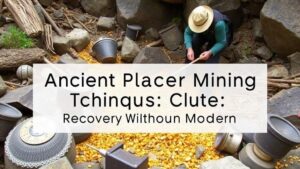Simple Techniques for Testing Sediment for Gold Without Specialized Tools
Introduction
Gold panning and prospecting have captivated individuals for centuries, with simple methods proving effective even without specialized tools. In this article, we delve into straightforward techniques for testing sediment for gold, providing practical tips that can be employed by anyone interested in gold prospecting.
The Basics of Gold Prospecting
Before exploring techniques for testing sediment, its essential to understand why certain locations are more promising for gold. Gold is typically found in areas where geological processes have concentrated it, such as near riverbeds, creeks, and erosion zones of mountains.
Characteristics of Gold
Gold has distinct properties that make it easier to identify during sediment testing:
- Density: Gold is notably dense, with a specific gravity of 19.3, which allows it to settle at the bottom of containers.
- Color: Freshly exposed gold exhibits a bright yellow hue, while tarnished gold appears darker.
- Malleability: Gold can be easily shaped without breaking, which can be helpful during identification.
Simple Techniques for Testing Sediment
1. Panning
Panning is perhaps the oldest and most straightforward method for prospecting gold. The procedure involves using a shallow pan to separate heavy materials, like gold, from lighter sediments.
- Fill the pan: Gather sediment and fill the pan about halfway.
- Submerge and shake: Submerge the pan in water and shake it gently. This action allows lighter materials to wash away.
- Rinse: Tilt the pan to let water flow out while keeping the heavier materials at the bottom.
- Inspect: Continue rinsing until only the heaviest materials remain, then look for gold particles.
2. Using a Sluice Box
A simple sluice box can help concentrate gold from larger volumes of sediment. While you can purchase a sluice box, you can also create a rudimentary version using a sturdy container, an incline, and some riffles made from natural materials.
- Set Up: Position the sluice box in a flowing stream.
- Add Sediment: Load sediment at the top end of the sluice.
- Flowing Water: The water will carry lighter materials away while trapping heavier substances like gold in the riffles.
3. Magnet Method
Gold is not magnetic, unlike many iron-based minerals that might be present in the sediment. Using a simple magnet can help to quickly separate these unwanted materials.
- Use a strong magnet and pass it over the sediment.
- Collect the magnetic materials separately, which will help concentrate the non-magnetic materials, including potential gold.
Identifying Gold in Sediment
Visual Inspection
Also to the above techniques, visually inspecting the residue left after panning or using the sluice box is crucial. When examining sediments, look for:
- Bright yellow specks or flakes.
- Small nuggets that might have been trapped with other minerals.
Using Water to Enhance Visibility
To further aid in the identification of gold particles, using a water method can enhance visibility:
- Pour the remaining sediment into a container with clean water.
- Gently agitate the mixture. The movement will help separate heavier materials from lighter ones.
- Inspect the bottom for any visible gold that may have settled.
Conclusion and Future Applications
Testing sediment for gold without specialized tools is entirely feasible with simple techniques such as panning, using a sluice box, and employing magnets. Understanding the basics of gold prospecting, combined with these methods, can enhance the prospecting experience.
As you apply these techniques, keep in mind the importance of permitting and environmental sustainability in prospecting practices. The joy of finding gold can not only lead to a potential financial windfall but can also contribute to our understanding of the earths geology.
Actionable Takeaways
- Begin your gold prospecting journey by choosing locations with promising geological features.
- Practice each technique, as familiarity improves your efficiency and success rate.
- Stay informed about regional regulations regarding gold prospecting to ensure responsible practices.


